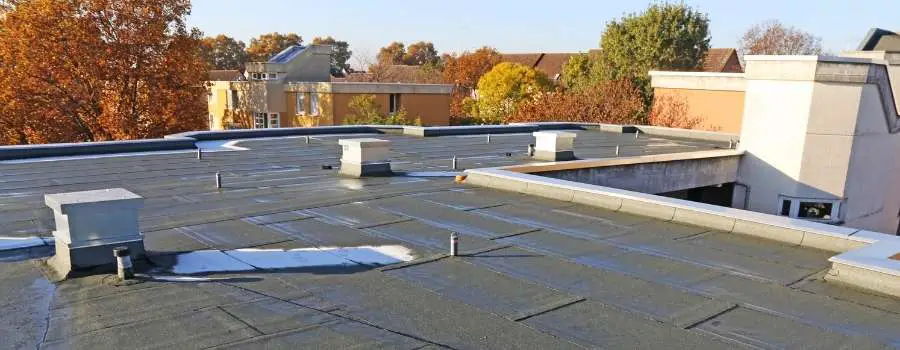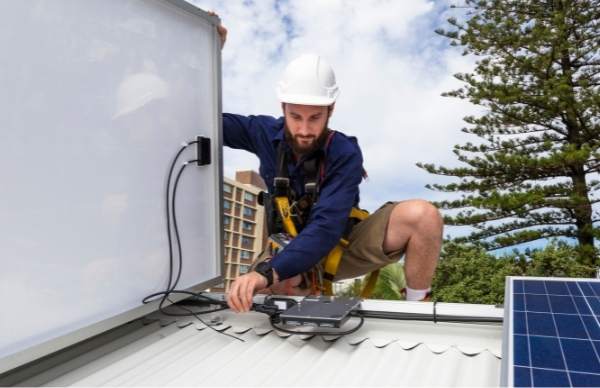
Solar panels are typically found on slanted rooftops in residential and commercial areas. However, some people live or work in structures that have flat roofs instead. So it’s crucial to ask, are there any solar panel racking solutions available for flat roofs?
There are three types of solar panel racking that is designed for flat rooftops: attached, ballasted, and foundation-type racking. Choosing the best racking option for your structure is crucial to avoid creating leaks in your roof or putting the solar panels at risk from heavy winds.
With careful planning, you can enjoy solar power benefits, even with a flat roof. I’ve put this article together to help you understand what to look for when choosing solar panel racking for flat roofs and help you to decide which of the three types will work for you (1).
Table of Contents
Types of Solar Panel Racking for Flat Roofs
Racking systems are the foundation on which solar panels are mounted and can significantly impact the overall effectiveness and durability of the solar installation.
Each type comes with its unique set of features, advantages, and considerations, making them suitable for different scenarios and needs (2).
Ballasted Racking Systems
Ballasted racking systems are designed for flat roofs and involve mounting solar panels on weights or ballasts. These systems rely on the weight of the ballasts, typically made of concrete or other heavy materials, to secure the solar panels in place. This design eliminates the need for penetrating the roof, thus preserving its integrity. The racking frames are often angled to optimize solar exposure.
Pros:
- Non-Penetrative Installation: Ideal for roofs where drilling is not feasible or desirable.
- Ease of Installation: Typically easier and quicker to install compared to other systems.
- Flexibility: Can be easily repositioned or removed if necessary.
- Roof Protection: Reduces the likelihood of leaks or damage to the roofing material.
Cons:
- Weight Limitations: Not suitable for roofs with weight restrictions or weak structural support.
- Wind Resistance: Less aerodynamic, requiring careful consideration in high-wind areas.
- Space Efficiency: May require more space due to the design and layout constraints.
Mechanical Attachment Systems
Mechanical attachment systems involve anchoring the solar panels directly to the roof structure using mechanical fasteners. This method typically requires drilling into the roof and attaching the racking system to the building’s support structure. Unlike ballasted systems, mechanical systems are directly integrated with the roof, offering more stability and less susceptibility to wind uplift.
Pros:
- Increased Stability: Provides a more secure attachment, especially in areas with high wind or extreme weather conditions.
- Space-Efficient: Allows for a more compact layout, maximizing solar panel density.
- Scalability: Easier to scale up for larger installations.
Cons:
- Roof Penetration: Potential for leaks and damage if not installed correctly.
- Installation Complexity: Requires more precise installation and understanding of the roof’s structural integrity.
- Inflexibility: More challenging to reconfigure or remove compared to ballasted systems.
Hybrid Systems
Hybrid racking systems merge the benefits of both ballasted and mechanical attachment systems. They typically use a lighter ballast in conjunction with limited mechanical attachments. This approach provides additional stability without significantly increasing the load on the roof.
Specific Advantages for Flat Roofs:
- Enhanced Stability: Offers improved resistance to wind uplift while minimizing roof load.
- Versatility: Suitable for a wider range of roof types, including those with moderate weight limitations.
- Reduced Roof Impact: Limits roof penetration, decreasing the likelihood of leaks or structural damage.
- Installation Flexibility: Easier to adapt to different roof layouts and conditions.
Hybrid systems represent a middle ground, combining the ease of installation of ballasted systems with the stability of mechanical systems. They are particularly beneficial for flat roofs where weight and wind resistance are critical considerations.

Special Considerations
Installing solar panels on flat roofs requires careful consideration of several unique factors. These aspects help the efficiency, safety, and longevity of the solar installation (3).
Structural Integrity and Load Capacity
- Assessment of Roof Strength: Before installation, evaluate the structural integrity of the roof. The additional weight of the solar panels and racking systems, especially in ballasted setups, can significantly impact the roof’s load-bearing capacity.
- Engineering Analysis: A professional assessment, often involving an engineer, should determine if reinforcements are needed to support the extra weight. This is especially important in older buildings or those not initially designed with solar installations in mind.
Water Drainage and Waterproofing
- Avoiding Water Pooling: Flat roofs are more prone to water pooling, which can lead to leaks or damage over time. The solar panel installation must not impede the roof’s natural drainage paths.
- Waterproofing Measures: Make sure any roof penetrations made during the installation of mechanically attached systems are properly sealed and waterproofed to prevent leaks.
Wind Uplift Considerations
- Aerodynamic Design: Flat roofs expose solar panels to higher risks of wind uplift. Racking systems need to be aerodynamically designed to withstand wind forces, particularly in regions prone to high winds.
- Securing Panels: Both ballasted and mechanical systems should be evaluated for their resistance to wind uplift, with additional anchoring or weight as required.
Accessibility and Maintenance
- Ease of Access: Regular maintenance and cleaning are important for optimal solar panel performance. The design should allow for safe and easy access to the panels for maintenance purposes.
- Maintenance Plan: Developing a maintenance plan, including routine inspections and cleaning, is essential to maintain efficiency and prevent potential issues.
Temperature and Ventilation
- Heat Impact: Solar panels can increase the roof’s temperature, which in turn can affect the building’s internal temperature. Adequate ventilation must be ensured to minimize this impact.
- Spacing for Airflow: Proper spacing between the solar panels and the roof surface is crucial for allowing air circulation, which helps in cooling both the panels and the roof.
Compliance with Local Regulations and Building Codes
- Building Codes: Every locality has specific building codes and regulations that govern solar panel installations. It’s vital to comply with these requirements to ensure safety and legal compliance.
- Permitting Process: Navigating the permitting process can be complex. Professional installers often assist with this, ensuring that all aspects of the installation meet local guidelines.
Optimizing Available Space
- Efficient Layout: Flat roofs offer a unique advantage in terms of space. Unlike sloped roofs, they allow for a more uniform and flexible arrangement of solar panels. This means more panels can be installed, optimizing the available space.
- Adjustable Configurations: Racking systems on flat roofs can be easily adjusted and configured to maximize panel density. This adaptability helps make sure that every inch of roof space can be effectively utilized for solar energy production.
- Minimized Shading: With the right layout, flat roof racking systems can be designed to minimize shading from surrounding structures or other panels, further enhancing the space’s energy-producing potential.
Enhanced Energy Efficiency
- Optimal Tilt and Orientation: One of the key factors in maximizing solar energy production is the tilt and orientation of the solar panels. Flat roof racking systems allow for the panels to be positioned at the ideal angle and orientation, regardless of the roof’s own angle, to guarantee maximum exposure to sunlight throughout the day.
- Seasonal Adjustments: Some racking systems offer the flexibility to adjust the tilt of the panels seasonally, which can significantly increase energy production as the sun’s position changes throughout the year.
- Uniform Exposure: By facilitating uniform exposure to sunlight for all panels, these systems can optimize the efficiency of each panel, leading to higher overall energy production.
Durability and Reliability
- Robust Materials: High-quality materials such as stainless steel, aluminum, and UV-resistant polymers are commonly used in these racking systems, offering resistance to corrosion, rust, and weather-related wear and tear.
- Engineered for Strength: The design of flat roof racking systems often includes considerations for load distribution, wind resistance, and structural integrity. This engineering ensures that the systems can withstand diverse environmental conditions over long periods.
- Protective Features: Many systems come with additional protective features like edge guards and weatherproof coatings, which enhance their durability and reduce maintenance needs.
